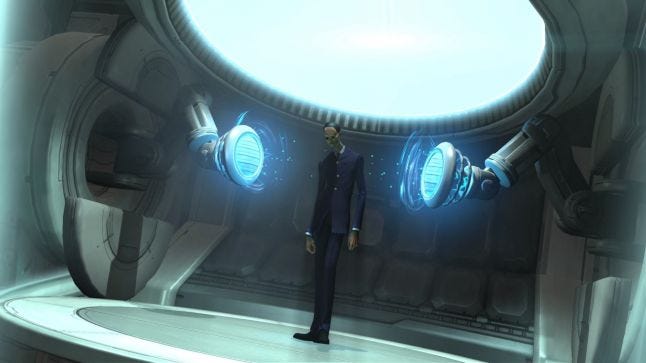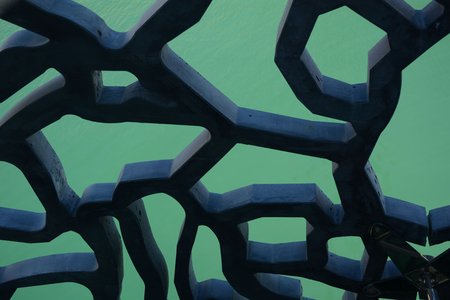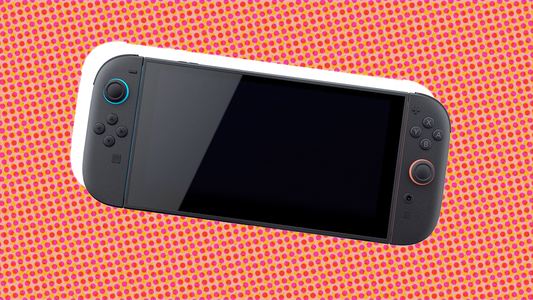In honor of the 5th anniversary of the release of the brilliant XCOM: Enemy Unknown, we present this classic postmortem, which first appeared in the January 2013 issue of Game Developer magazine.
The game was a "reimagining" by Firaxis of the classic 1994 strategy title UFO: Enemy Unkown, as well as a reboot of the XCOM series. It was a smashing success, earning numerous awards and GOTY accolades.
This in-depth look at what went right and what went wrong during development was written by Garth DeAngelis, who was the lead producer and a level designer on XCOM: Enemy Unknown.
There may have been wounds, but somehow, the XCOM: Enemy Unknown development team evaded permanent death.
In 1994, Microprose released a special PC game called UFO: Enemy Unknown. The turn-based strategy title accumulated a devoted fanbase for its unique take on high-level management against an alien invasion blended with boots-on-the-ground, intimate combat controlling individual soldiers. Fast-forward almost two decades, and Firaxis Games has released XCOM: Enemy Unknown, a reimagining of Julian Gollop’s original design.
The road to completing XCOM was an arduous one. We made many of the same mistakes that other devs have made (and documented in previous Game Developer postmortems): feature creep, communication shortfalls, not enough time, not enough people… If you’re a game developer, you know the story. But through it all, the entire team remained resolute, and in October 2012, against all odds, the development team managed to save Earth ship XCOM on PC, Xbox 360, and PlayStation 3.

WHAT WENT RIGHT
1) UPHELD THE SPIRIT OF THE ORIGINAL
Lead designer Jake Solomon planted a small seed within the creative walls of Firaxis Games in 2004. As the self-proclaimed “biggest fan of the original X-COM” and as a designer/programmer working directly with Sid Meier, it made sense to spark discussion regarding resuscitating one of the greatest strategy titles of all time. After shipping Civilization Revolution, the stars began to align, and the rebuilding of XCOM became a reality.
Before any code was written or any art completed, Jake defined core pillars that would act as the foundation for pillars that would act as the foundation for designing the rest of the game. All facets of game development had clearly evolved since 1994, from game and narrative design to user interface, but Jake remained adamant that certain high-level elements from the original remain holy. These inspirations included maintaining a turn-based combat system, which seemed risky in the modern age of frenetic first-person shooters and real-time action games.
The game would also preserve the symbiotic relationship between the micro combat layer and a macro, grand strategic mode, where the player runs and builds their own secret headquarters to counter the simulated alien invasion. Fans of the original game understood the appeal of these interdependent systems, but to those unfamiliar with the XCOM franchise, this was a foreign game structure, and that equaled potential big risk.
Other smaller pillars included: updating systems such as the fog of war and how visibility would be communicated to the player in a 3D environment; fully destructible environments, a satisfying staple from UFO: Enemy Unknown, but a potential challenge in a game of this scope; reintroducing players to permanent death, and the fact that when it comes to XCOM soldiers, there are no such things as extra lives; and recreating the tense atmosphere from the original.
It was critical to place the player in a world they recognized—in settings they may recall from their own neighborhood or city—and then introduce a menagerie of new and classic aliens into these usually safe environments. This led to an unnerving despair that XCOM fans are all too familiar with. Collectively, these pillars provided the foundation for a challenging experience that presented true consequences, just like UFO: Enemy Unknown.

2) Building the vision early
Firaxis underwent a pitch process that previously had not been attempted with past projects, but then again, we were pitching what was essentially a new IP as a big-budget endeavor, so we needed to make a major splash.
Getting the green light to remake an antiquated turn-based strategy game would be a challenge, and simply verbalizing what made XCOM so special and ripe for a rebirth wouldn’t be enough. The team needed something that would make everyone understand why we were so passionate about undertaking this project—something beyond a static presentation.
Jake began working with project art director Greg Foertsch and a small band of artists to create a gameplay previsualization. Over the course of multiple months, Greg and his team ate, breathed, and slept UFO: Enemy Unknown, ultimately planning a storyboarded sequence that would illustrate how Firaxis’s take on the XCOM universe would not only look, but also how it would play.
On Fridays, Jake would sit in a room with the team while they immersed themselves in the original game, becoming familiar with its nuances and big concepts alike. This collaboration led to a compelling previsualization that not only got the development team on the same page, but also communicated to nondevelopers the potential for a classic turn-based experience to be reborn as something cutting edge, distinctive, and thrilling in the modern age of video games.

3) Overcoming the “accessible” stigma
Even before beginning work on XCOM , we heard it all before: Games had become too easy. The development (or marketing) buzzword “accessible” translated to “dumbing down,” the idea that developers would take an otherwise deep, rich, and satisfying game and distill its intricacies to its barest form so the entirety of the world could understand, buy, and play said game.
It sounds hyperbolic, but I’ve seen games with easy modes that literally played themselves, making failure impossible, so this stigma against accessibility wasn’t without merit! Making a game “for the masses” could be the ultimate transgression, especially for a complex game with a hardcore past, and we anticipated that XCOM fans would be skeptical that our work would hold up to those who fell in love with the original.
While UFO: Enemy Unknown may have been magnificent, it was also a unique beast when it came to beginning a new game. We often joked that the diehards who mastered the game independently belonged in an elite club, because by today’s standards the learning curve was like climbing Mt. Everest.
As soon as you fire up the original, you’re placed in a Geoscape with the Earth silently looming, and various options to explore within your base—including reading (unexplained) financial reports, approving manufacturing requests (without any context as to what those would mean later on), and examining a blueprint (which hinted at the possibility for base expansion), for example—the player is given no direction.
Even going on your first combat mission can be a bit of a mystery (and when you do first step off the Skyranger, the game will kill off a few of your soldiers before you even see your first alien—welcome to XCOM!). While many fans on the team found this learning curve to be a part of the game’s charm and wore it as a badge of honor, we ultimately knew that, in 2012, we needed to enable gamers to experience the truly fun elements without overly testing their patience. But neither could we bear to dumb XCOM down.

We were on a mission to flip the perception on streamlining, to remove the stigma that accessibility equaled a dirty word. We wanted anyone to be able to give XCOM a whirl without expecting them to become fluent in the game’s many systems on their own accord. At the same time, we needed to preserve all of the richness, depth, and challenge ingrained in the core pillars. If someone wanted to walk away from the experience due to the game’s challenge, we were okay with that; but we didn’t want to alienate anyone simply due to a lack of information.
To accomplish this, we built an optional, integrated tutorial that peeled off the components of XCOM one layer at a time. It was important to keep this hour-and-a-half experience optional, as experienced players could save Earth again without the tutorial force-fed to them (and we also knew some players, even in 2012, would want that old-school badge of honor by skipping the tutorial altogether, which is somewhat appropriate for certain types of X-COM fans).
The introduction to the game wasn’t the only area we redesigned. Jake and the design team refined low-level mechanics from the original, such as removing Time Units and capping the squad loadout at six. Both of these changes were the result of internal playtesting over the course of many months, with the development team finding a combat “sweet spot” with respect to approximate time spent on a map and number of decisions made per turn (we found, depending on map size, battles should average 20 minutes, not to exceed 50 minutes on the absolute longest missions). Six units also made every decision vitally important, promoting group tactics with no moves feeling like unnecessary filler.
This “new era of accessible” mindset also helped the design and user interface teams build a platform-agnostic experience. This is an element that could have gone horribly wrong (and did have its inherent challenges, detailed later), but the team did an admirable job of crafting a historically PC experience for consoles as well. We knew games like XCOM weren’t traditionally available on Xbox 360 and PlayStation 3, but we’re extremely happy we could provide the same experience (without compromising features or “dumbing down” the console versions) across all platforms.

4) DEDICATED TEAM EFFORT
The developers at Firaxis are extremely professional, with each discipline playing the hero role at some point and overcoming monumental obstacles throughout development. From the audio group to the animation and narrative team, they were continually course-adjusting due to dependencies, yet still producing incredible content to polish the game.
On the engineering front, months of changing design had to be technically supported in many complex situations. Systems were built, iterated upon, and some were even discarded after determining a new direction was needed. For example, over the course of a few milestones in midproduction, design asked for sightlines to be drawn from every game unit, soldier, and alien alike, so it was clear what each unit could see.
Our graphics engineering team and artists diligently worked to make this system digestible, but unfortunately, it was tough for the player to determine what was going on amidst the plethora of multicolored lines. After months of trying to get sightlines to work, we eventually realized that the strongest solution was to remove them.
There were plenty of other challenging systems to decipher: the building visibility system underwent various ceiling, wall, and floor rule changes; destruction fidelity fluctuated through a shaky toughness system; and the fog of war was a full 3D cloud early in production, which proved to be a nightmare for both graphics engineering and performance.
Additionally, each gameplay layer (combat and strategy) received drastic overhauls after months of playtesting. In all of these cases, initial engineering efforts had to ultimately be thrown out. To the team’s credit, they understood the nature of iterative design and admirably continued to put in the time needed to make the game a better experience.

In addition, the engineers banded together in a Herculean effort to fix thousands of bugs in postproduction. XCOM is a large, system-driven game with many procedural elements. This meant that many bugs were not only difficult to reproduce, but challenging to even find! Together, engineering raised the bar of the final player experience by squashing these bugs feverishly. Obviously, we couldn’t find and fix every bug, but we’re proud of the effort given in the race to the finish line.
The art and content teams also worked minor miracles. A primary example was the game’s levels. We all love maps and levels, and want more of them; but they are a nexus of many different disciplines somehow crafting the same sculpture all together, and this requires tight coordination and lots of time. Firaxis had never created a level-driven game before (with a strategy system still on top of it, no less), so we had to learn how to build a pipeline that would let us efficiently design and build level assets.
This specifically required an inordinate amount of collaboration between level design and level art, weeks of gameplay testing and feedback per map, and an extreme amount of content creation (we needed to have approximately enough maps for two full playthroughs). In the end, our modestly sized level team ended up exceeding the original goal of 70 unique maps.
Beyond levels, there was still an entire headquarters to build on the strategy layer, with dozens of expandable rooms that could be hand-placed by the player. After making various isometric prototypes, we realized the base wasn’t nearly as gripping as we’d like; something was missing.
No tags.




































